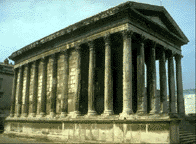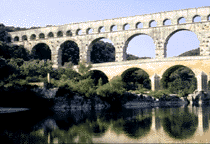|
|
|
|
|
|
|
|
|
|
|
|
|
|
|
|
|
|
|
|
|
|
|
|
|
|
|
|
|
|
|
|
|
|
|
|
|
|

The Era of the Roman Empire
If you particularly enjoy exploring the vestiges of Roman antiquity, you will be well rewarded in Provence, for there are a number of impressive sites to be seen, in various stages of preservation.
After the Battle of Actium in 36 B.C., when the Roman Republic became the Empire, and Octavian became Augustus, Roman policy changed toward settlements outside of Italy. Before they had been considered only sources of wealth to be pillaged for Rome's enrichment. However, the Emperor Augustus devised a brilliant plan to solve some of Rome's own long-standing social unrest. It seems that, for more than a hundred years, landless peasants, idle and rebellious veteran soldiers, and a growing population which -- spoiled by their dependence on slaves -- no longer wanted to work, were causing civil war and a shortage of food. Augustus decided to treat the provinces as an extension of Rome, where landless citizens could be settled to produce food and goods for the Italian peninsula. Aging legionnaires could also be settled there, removing them as a source of unrest in Rome and at the same time protecting the borders of the expanded Empire.
Augustus gave the town of Arles to the Sixth Legion of Julius Caesar as a reward for their victory over Pompey at Marseille. The town of Orange was bequeathed to the Second Legion, in recognition of their service in the Gallic Wars. Nîmes (Nemausus) was bestowed on the legions which had defeated Antony and Cleopatra at Actium. To make his soldiers feel at home in their new digs, Augustus created miniature replicas -- or clones -- of Rome in each of the cities, by building arenas, baths, forums, temples, and theaters on a smaller scale based on their population.
Arles
(38 km N of Stes-Maries-de-la-Mer, 92 km NW of Marseille,
36 km S of Avignon)
In its Celtic-Ligurian beginnings, the town had two names, Theline (the Provider), which was replaced by Arelate (the town in the marsh). The Greeks arrived from Marseille during the 6th century BC, and Arles subsequently became a commercial crossroads under Roman rule, with merchants coming from as far afield as Arabia, Assyria, and Africa, lingering to trade here on their way from Rome to Spain or northern Europe. Before the Mediterranean receded over what is now the Camargue, Arles used to be a thriving port, and the site of the southernmost bridge over the Rhône.
As it was the first
Roman foundation in Gaul, Arles became known as "the little Rome of
the Gauls". Roman society has left its mark on this city, evidenced
by several sites which are popular tourist attractions. The most
notable of these is the 26,000-seat Arènes,
built in the 1st century AD for circuses and gladiator combat. The
amphitheater is 150 yards long and as wide as a football field, with
60 arches in each of its two stories; an original top tier has long
since crumbled, and three square towers were added during the Middle
Ages. Today, it still draws large crowds, primarily for its Sunday
afternoon bullfights. [Provençal bullfighting does not kill
the animal; the objective here is to retrieve a rosette attached to
its forehead, without being gored by the bull.]
Address: Rond-Point des Arènes. Phone: 04-90-96-03-70.
Admission: 15 FF (55FF for a passport to all museums and monuments in
Arles). Hours: June - Sept., daily 8:30am - 7pm; Nov. - Mar., daily
9am - noon and 2 - 4:30pm; Apr. - May and Oct., daily 9am - 12:30pm
and 2 - 6:30pm.
Though the
diminished remains of the Théâtre Antique
only hint at the former grandeur of this Roman theatre which once
held 7000 spectators, the orchestra pit and a few tiers of seats --
between bits of marble column scattered throughout the grassy
enclosure -- still provide accomodation for the city's Music and
Drama Festival each July.
Address: rue du Cloître. Phone: 04-90-96-93-30. Admission: 15
FF (joint passport available, as described above). Hours: (same as
for the Arènes ).
[Arles is also known as the town where the famous Dutch painter, Vincent van Gogh, produced much of his best work (and chopped off his ear) during a frenzied 15-month period (1888-90) just before his suicide at age 37.]
Nîmes
(20 km SW of the Pont du Gard, 43 km S of Avignon)
Nîmes {neem},
today the capital city of the Gard department, is one of the finest
examples of prosperous Gallo-Roman settlements in southern France.
Originally named Nemausus (for the local god of spring), the city
served as a regional Celtic capital. Though succumbing to Roman
control in 121 BC, the city's continued importance was assured by its
location on the Via Domitia, the main Roman road between northern
Italy and Spain.  Soon
after the residents received Roman citizenship (c.28 BC), the city
was replanned with an organized street grid, and it gradually
acquired the monuments considered indispensable to a Roman
municipality. These included a 6-km-long (3.7-mi) city wall with
impressive gates enclosing an area of 2.23 sq km (.86 sq mi). Within
this area were built a forum with temples, an amphitheater, a
watchtower, and a fountain sanctuary. Inscriptions indicate that
extensive baths were also built. Under Hadrian (r.117-38 AD) the city
achieved great prosperity, and a basilica was added to the forum.
Soon
after the residents received Roman citizenship (c.28 BC), the city
was replanned with an organized street grid, and it gradually
acquired the monuments considered indispensable to a Roman
municipality. These included a 6-km-long (3.7-mi) city wall with
impressive gates enclosing an area of 2.23 sq km (.86 sq mi). Within
this area were built a forum with temples, an amphitheater, a
watchtower, and a fountain sanctuary. Inscriptions indicate that
extensive baths were also built. Under Hadrian (r.117-38 AD) the city
achieved great prosperity, and a basilica was added to the forum.
The best-known
monument of Nîmes is the Maison Carrée, a
remarkably well-preserved oblong Roman temple built during the 1st
century AD, featuring exquisite carvings along the cornice and on the
Corinthian capitals. Today, the building is a museum, and contains an
imposing statue of Apollo.
Address: bd. Victor-Hugo. Admission: free. Hours: May-Oct., daily
9am-7pm; Nov.-Apr., daily 9am-6pm.
A smaller version of
the Colosseum in Rome, the Arènes of Nîmes
is more than 140 yards long, 110 yards wide, with a seating capacity
of 21,000. Considered the world's best-preserved Roman amphitheater,
it is still used today for bullfights and tennis tournaments in the
summer.
Address: bd. Victor-Hugo. Phone: 04-66-67-45-76. Admission: 22 FF.
Hours: May-Oct., daily 9am-6:30pm; Nov.-Mar., daily 9am-noon and
2-5pm.
At the summit of the 374ft (114m) Mont Cavalier stands the 112ft (34m) octagonal Tour Magne. Of all the towers originally set in Nîmes' Roman wall, this is the largest and most remarkable. Dating from 15 BC, it is the earliest surviving Roman building in France. There are 140 steps leading to the top, where there is a fine view of Mont Ventoux.
[In more recent history, Nîmes acquired a rich reputation for its textiles, similar to Marseilles. The word "denim" originated from de Nîmes, and it was exported through Gênes (or Genoa); since most people couldn't properly pronounce the name, it was transformed into "jeans".]
Orange
(10 km N of Chateauneuf, 31 km N of Avignon)
[Formerly the Celtic capital, Arausio, later colonized by veterans of the Roman Second Legion. Present name dates from a much later period when the town was the property of the House of Orange, the royal family of the Kingdom of the Netherlands.]
The magnificent,
semicircular Théâtre Antique, situated in
the center of town, is the best-preserved remains of a theater from
the Roman Empire, built just before the birth of Christ. Unlike its
similarly-sized but poorly preserved counterpart in Arles, the
Théâtre in Orange has a mighty screen wall and steeply
climbing terraces carved into the hillside. Accomodating 7,000
spectators, its acoustics are superb; a spectator sitting in the
highest "nosebleed" seat can still clearly distinguish hushed speech
coming from the stage. This is also the only Roman theatre still
possessing its original Imperial statue of Caesar Augustus, which --
at 12 feet in height -- is one of the tallest in existence.
Address: pl. des Frères-Mounet. Phone: 04-90-34-70-88.
Admission: 30 FF. Hours: Apr.-Oct., daily 9am-6:30pm; Nov.-Mar.,
daily 9am-noon and 1:30-5pm.
Orange's other monument of ancient civilization is its Arc de Triomphe, built around 25 A.D. in honor of the Gallic Wars. Topped by a massive entablature, the 70-foot central arch is flanked by two smaller ones, and formerly towered over the Via Agrippa in Roman days; today, it presides over a busy traffic circle.
Pont du Gard
(22 km SW of Avignon, 37 km SW of Orange, 48 km N of
Arles)
Lacking electricity or the means to pump water to the cities from springs and reservoirs in the mountains, the Romans devised an elaborate and precisely engineered system of aquaducts to carry the water -- often hundreds of miles -- using only gravity and the very slightest downward grade (1mm per meter).
 The magnificent evidence of one such
aquaduct can be found at the Pont du Gard, which
crosses a rocky gorge 150 feet above the River Gardon. This
spectacular, 3-tiered aquaduct was built by Marcus Agrippa during his
two-year governorship of Gaul, 20 to 19 B.C. The blocks of masonry --
some weighing as much as six tons -- were cut so precisely that they
were laid without mortar or cement, after being hoisted by hundreds
of legionnaires and slaves. They stand as solidly today as when they
were put in place two thousand years ago, even though many more
modern bridges across this river have been repeatedly washed away.
The magnificent evidence of one such
aquaduct can be found at the Pont du Gard, which
crosses a rocky gorge 150 feet above the River Gardon. This
spectacular, 3-tiered aquaduct was built by Marcus Agrippa during his
two-year governorship of Gaul, 20 to 19 B.C. The blocks of masonry --
some weighing as much as six tons -- were cut so precisely that they
were laid without mortar or cement, after being hoisted by hundreds
of legionnaires and slaves. They stand as solidly today as when they
were put in place two thousand years ago, even though many more
modern bridges across this river have been repeatedly washed away.
For nine hundred years, the 31-mile canal supplied twenty thousand cubic meters of water daily from the springs of Eure to the Roman city of Nemausus (Nîmes), a difference in elevation of only fifty-six feet. Incredibly, during those nine centuries, the canals didn't leak: they were waterproofed with a combination of lime, pork fat, and the latex of unripe figs.
Astonishingly well-preserved, with no entry fee or guide, the Pont du Gard may be explored either by walking across the top (with its dizzying view of the gorge) or through its internal duct-way (in dimensions, similar to many hallways). Although you may best gauge its full majesty from the top, a word of caution is in order: this is not for the faint of heart, and not recommended on a very windy day (no safety rail)!
| |||||||||||||||||

|
||||||||||